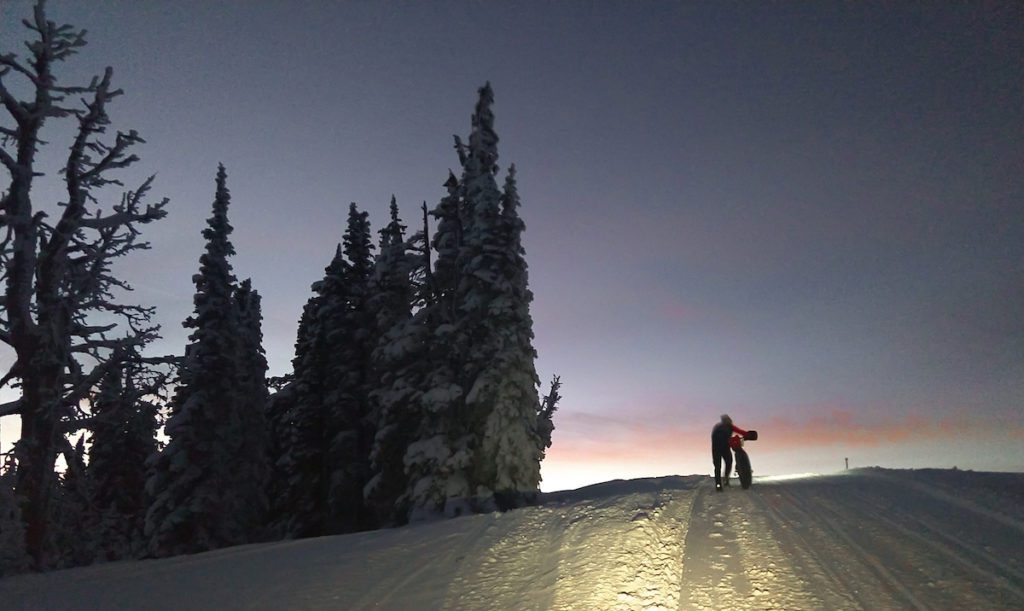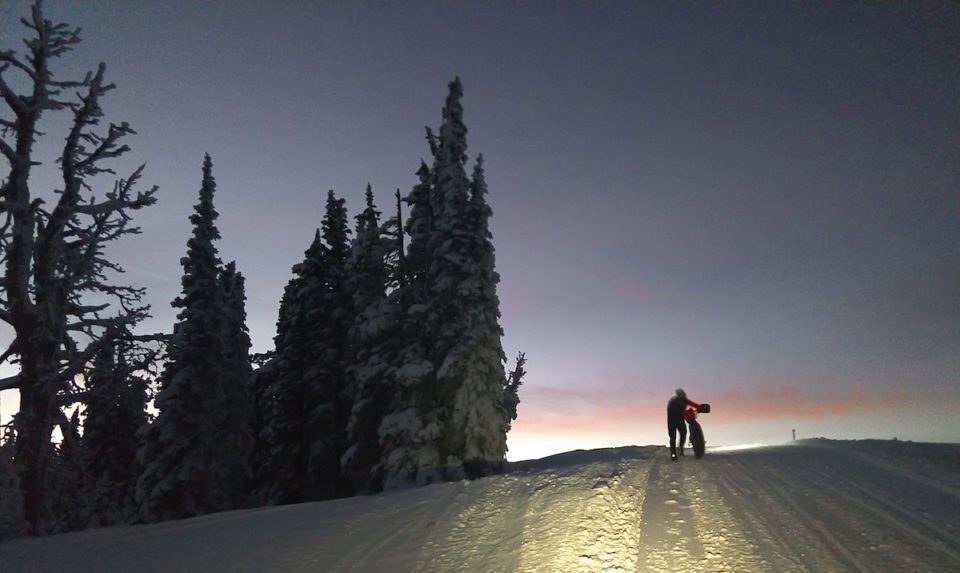Don’t about your neck of the woods, but snow country out in the West is going bonkers. Perhaps you’d still like to get out on your bike though – even for some honest-to-goodness adventures. Well, here’s your guide. This is part of our archive of thousands of stories. Felt appropriate to reshare considering the bonkers weather. – Ed.
I can’t say that I’m much of a winter person these days, and I’m certainly no fat bike fanatic. Sure, I grew up as a Nordic ski racer in Minnesota, but these days, I live in Arizona and relish riding and hiking on dry dirt and rocks all year long. It’s not that I dislike adventuring in the snow – it’s simply not my preference. But last week, I unexpectedly found myself in Idaho, chasing cyclist/guide/author Jay Petervary up a groomed singletrack climb on obnoxiously wide tires through the forest above Victor. And boy was I ever grinning. Petervary is the organizer of the Fat Pursuit, a winter ultra on the snowmobile trail network west of Yellowstone National Park with 200-mile and 200-kilometer distances. The race was a scant week away, and he and other friends in the Teton Valley were all encouraging me to throw my hat in. The only problem was that I had brought virtually no winter gear to Idaho, I didn’t have a fat bike, and I hadn’t really ridden on snow in years. No problem, the friends all said, offering up everything I’d need, including a bike and ample advice. After a few days of trying, and failing, to generate excuses for why I shouldn’t do the race, I registered for the 200-miler.
That week was a whirlwind of learning everything I needed to know about riding snow, winter gear, keeping warm and dry, clothing redundancy, tire pressure, frozen foods, keeping my water from solidifying, and so much more. And fortunately, I had a crack team of experienced friends eager to help out with the learning. This is what I learned about longer-distance winter pedaling and winter ultras.
 After nearly 20 hours of racing, Neil Beltchenko pushes his bike up the last pitch to the Continental Divide near Two Top Mountain under a pastel dawn. Photo: Refsnider
After nearly 20 hours of racing, Neil Beltchenko pushes his bike up the last pitch to the Continental Divide near Two Top Mountain under a pastel dawn. Photo: Refsnider
• Proper pogies (boxing glove-like handwarmers for your bars), riding boots, and a good sock system are game changers. Growing up in the Midwest, I used to ride with oversized cross-country shoes, extra pairs of socks, and two pairs of booties, and my feet still froze. I also rode in two-piece expedition mitts to keep my hands warm. But pogies like the Cobrafist from 45NRTH or the notably warmer Expedition Pogies from Revelate Designs allow you to ride with just light gloves (or none at all) on your hands in cold weather. And footwear designed for winter riding (I used the 45NRTH Wölvhammer boot) kept my feet mostly warm down to 5 °F. Along with the boots, I wore a liner sock, a vapor barrier, and a thicker insulating sock. The vapor barrier keeps any sweat locked in so that the insulating sock and the boot’s insulation remain dry and effective. This is critical for keeping my sweaty feet warm for any ride longer than a couple of hours. I actually used thick chicken roasting bags picked up at the grocery store. They are durable enough to be used multiple times without worrying about your big toe poking through the end.
• If your front tire is feeling squirrely, let air out. And if you feel your rear tire is slipping, let air out. Mike Barklow, who finished the 200-miler completely self-supported this year, explained this simple concept. The idea of low tire pressure in fat tires was nothing new to me, but seeing how he and others would sometimes ride with 2 psi or less was a bit shocking. And it sure as heck worked like a charm in soft snow. Starting out a ride at 6 psi or so and gradually letting air out as needed worked well for me. And then when conditions firmed up, out came the pump to put more air back in. Carrying the pump in a pocket or somewhere on your body will also help ensure that the pump works when you need it – rubber o-rings can be fussy when temperatures dip too low. And simply put, the wider the tire, the better the flotation. The softer the trail and the heavier the load, the more you’ll want a wide tire (wide being something close to 5” across).
• Don’t let yourself sweat—ever. Everyone gave me this same advice. And for someone who sweats readily when working hard, this had me a bit nervous. But riding in just a pair of softshell pants and a long-sleeve base layer and long-sleeve wool jersey kept me comfortable if temperatures were between 10 and 25 °F. But as soon as I’d stop, I’d have to add a layer to keep from getting immediately chilled. A wind vest was also great for helping modulate core temperature easily. Below 10 °F, a softshell jacket and a thin base layer under my pants was essential.
• Bring extra of everything. Petervary emphasized this packing technique. He’s been racing ultras for longer than virtually anyone, and he never has the most svelte, minimalist kit in a race. But when conditions deteriorate, his extra gear has served him well, and I have so much respect for such an approach. I carried 2 extra pairs of light gloves, an extra hat, buff, and headband, a full change of socks and vapor barriers, an extra base layer, mid-weight expedition mitts, rain knickers, and a light-weight down jacket. I would also have carried a rain shell and gaiters had snow been in the forecast. I didn’t need all that extra clothing, but should anything have gone wrong, I would have been glad to have had it.

At just 2 psi or less, wide tires can even find some traction amid a dump of fresh snow. Photo: Refsnider
• Bring finger foods. “I like to cut my snacks and treats up into bite-sized pieces,” bike adventurer Nan Pugh told me with her typical grin. “Then you can let them defrost in your mouth.” Figuring out what didn’t freeze solid was a fun experiment, and then I did just as she suggested, filling a feedbag on the bike’s stem with bite-sized morsels. Perfect Bars, Bobo’s Oat Bars, peanut butter cups, and squares of dark chocolate kept me moving.
• The best way to keep water from freezing is either in a well-insulated thermos or in a bladder worn over your base layer and beneath any additional layering. I carried as much as 100 ounces of water in a bladder in this manner, and as long as I was good about keeping the hose and mouthpiece tucked into my shirt and against my chest, it never froze up. After every drink you take, also blow the water back through the hose to keep all the water close to the heat of your back.
• Having a way to melt snow for water and cook a warm meal is indispensable. In the Fat Pursuit, stoves were required equipment, and the first aid station insisted on seeing riders boil water immediately upon arrival! But don’t necessarily count on your typical warm-weather bikepacking stove to work in the cold. White gas stoves are generally fantastic in wintery conditions, while gas canister stoves that use propane or isobutane can be much more problematic. For these stoves, winter fuel mixtures that include higher propane-to-isobutane ratios are critical at sub-freezing temperatures, and doing whatever you can to keep the canister warm will help. Heat the canister in your jacket before you need to use it, move your hands back and forth between the warm pot and the canister while heating up water, and using a windscreen will all help dramatically. But if you plan to do much winter camping, investing in a white gas stove would be wise.

Boots like the 45NRTH Wölvhammer are designed specifically for winter riding – a moderately stiff sole, deep lugs for hiking traction, SPD cleat compatibility, and a bit of insulation. Size up 1-2 sizes or more for extra volume for wearing a multi-layer sock system. Photo: Refsnider
• An insulating sleeping pad is essential. Foam pads still reign supreme in cold temperatures, and although they’re bulky, they’ll really help insulate when sleeping on cold snow. Insulated inflatable pads are easy to find in outdoor stores, but they won’t be nearly as effective as a foam pad. I didn’t plan to sleep during the race, so just I carried an inflatable pad, but for any more relaxed trip, a foam pad would most certainly be part of my kit, likely in addition to the insulated inflatable pad for a taste of winter camping luxury.
• A typical bikepacking setup is fine. I carried all my gear on my bike using a fairly typical system – 0 °F sleeping bag, pad, and bivy on the handlebars, all my extra clothing in the seatbag, spare parts, tools, stove, and fuel in my frame bag, and goodies to keep me fueled in smaller bags on the top tube and stem. Alternatively, putting more weight on a rear rack and taking weight off the handlebars can help with handling on soft snow.
All the tips I was given before facing the Fat Pursuit paid huge dividends. I rode a Pivot LES Fat that I had just been loaned a couple days before the event, packed it up with all my loaned gear, brought way more layers than I thought I’d need, and settled into pedaling through the gorgeous wintery landscape at or near the head of affairs. I stopped frequently to add or remove clothing layers, adjusted tire pressure regularly, and swapped out my sock system once. 27 hours after the start I sprinted across the finish line. Remarkably, my untested system worked out phenomenally well, thanks to all the folks who shared their best advice.

The small pieces of kit that Kurt carried during the Fat Pursuit, from top left: Glue-on patch kit, chain lube, multi-tools, tire pump, tire lever, zip ties, tire plugs, chain links, spare cleat and bolts, small first-aid kit, Garmin eTrex 20 GPS for navigation, Fenix HL25 headlamp, Fenix BC21R handlebar light, extra lithium batteries for lights and GPS, Dermatone, Vargo BOT 700 pot, Olicamp 4-season stove fuel, Snowpeak stove, windscreen, hand warmers (6 pairs), spare tube, and emergency bivy. Photo: Refsnider


2 comments
Thank you for your sharing. I am worried that I lack creative ideas. It is your article that makes me full of hope. Thank you. But, I have a question, can you help me?
I really appreciate this post. I’ve been looking all over for this! Thank goodness I found it on Bing. You have made my day! Thanks again!